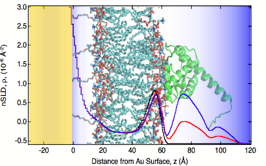 Here’s a neat bit of “bridge” or “glue” software for today – SASSIE is a python-based suite for creating atomistic models of molecular systems in order to compare those models directly to data from small-angle X-ray scattering (SAXS) and small-angle neutron scattering (SANS) experiments. SASSIE is the work of Joseph Curtis and Susan Krueger from the NIST Center for Neutron Research. You can use SASSIE to generate and manipulate large numbers of structures and to calculate the SANS, SAXS, and neutron reflectivity profiles from atomistic structures that result from molecular dynamics (MD) or Monte Carlo (MC) simulations.
Here’s a neat bit of “bridge” or “glue” software for today – SASSIE is a python-based suite for creating atomistic models of molecular systems in order to compare those models directly to data from small-angle X-ray scattering (SAXS) and small-angle neutron scattering (SANS) experiments. SASSIE is the work of Joseph Curtis and Susan Krueger from the NIST Center for Neutron Research. You can use SASSIE to generate and manipulate large numbers of structures and to calculate the SANS, SAXS, and neutron reflectivity profiles from atomistic structures that result from molecular dynamics (MD) or Monte Carlo (MC) simulations.
“Bridge” or “glue” software increases the functionality of other software by making the data formats from one package usable as input to another. In SASSIE’s case, the molecular dynamics package being used is NAMD (from the Theoretical and Computational Biophysics Group at UIUC), along with scattering calculators Cryson and Crysol. The Hydropro package is used for calculating hydrodynamic properties. (Note that Cryson, Crysol, and Hydropro are not open source programs. Boo.)
SASSIE isn’t quite a full-bore open source project yet. I was able to download the source here (159 MB download), but there’s a registration barrier in the way on the SASSIE trac site. I’m not sure why the small-angle scattering community locks up their code like this. It discourages re-use, and doesn’t provide any extra benefit to the authors of the code or the home institution. Likewise, Cryson and Crysol both appear to have an academic and research license (again, not open source).
SASSIE looks interesting. I’m not in the small-angle scattering community, but I really like the bridge between atomistic simulation and experiment, and the code looks like it has some very useful pieces that could be reused in interesting ways.

Hi Dan,
Thank you for your post regarding our software. I apologize for our in-ability to make our efforts fully open-source. This is really a by-product of developing “bridge” software as it makes distributing the results of our efforts difficult as we are limited by the licensing restrictions of others. This is a bit embarrassing as we are motivated to encourage the scattering community to make scientific coding efforts transparent as is the case in other communities.
We freely supply access to our source code following registration. The registration is merely a way to keep track of usage and avoid spam accounts from internet bots.
Cheers,
J